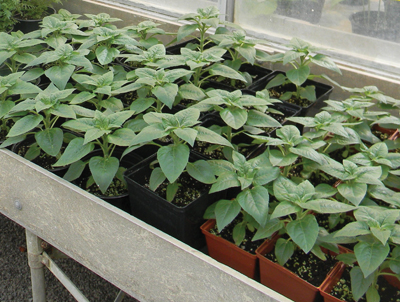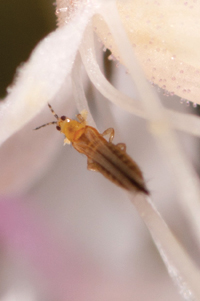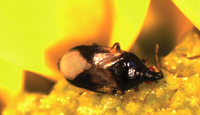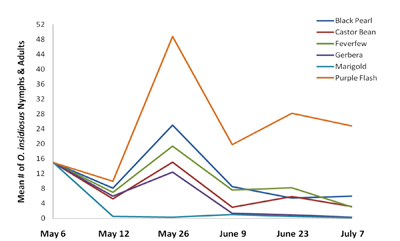
Features
Biocontrols
Inputs
Benefiting from ‘bankers’
February 7, 2012 By Meghann Waite Cynthia Scott-Dupree Graeme Murphy Michael Brownbridge and Rose Buitenhuis
In greenhouse ornamental crops, western flower thrips (WFT),
Frankliniella occidentalis, is one of the most economically important
and challenging pests to control.
In greenhouse ornamental crops, western flower thrips (WFT), Frankliniella occidentalis, is one of the most economically important and challenging pests to control. Insecticide resistance, worker health and safety considerations and a lack of effective new chemistries have provided incentive to increase the use of biological control agents.
 |
One of these biocontrol agents, the insidious flower bug, Orius insidiosus (Orius), is an excellent predator of WFT, and provides good control in greenhouse vegetable crops, such as sweet peppers.
The use of Orius in greenhouse ornamentals is limited, though, as the predatory bug can be slow to establish and exert control – a factor that is critical in these short-term crops. Relatively poor control is achieved as a result of two factors:
- A lack of prey, as WFT numbers are frequently low in the vegetative stages of plant development.
- Lack of additional food sources, as ornamentals typically are not flowering during production, so pollen is not readily available.
Additionally, the eggs of the predatory bug are removed from the greenhouse when the crop is shipped, so that predator populations cannot build up in the production area.
 |
|
| An adult female WFT; (top) Sunflower ‘Choco Sun’ was also among plants in the study. |
Establishing a “Banker Plant” system for Orius could provide an additional food source as well as a location for the predatory bug to reproduce and lay its eggs. A good banker plant will allow nymphs to reach the adult stage quickly, ensure a high survival rate, and support population growth.
A common example of a banker plant successfully used in greenhouse ornamental crops is the common barley plant on which the parasitoid Aphidius colemani is reared to control aphids. Currently, some commercial ornamental growers are trying to match the success of aphid banker plants by using the Black Pearl ornamental pepper as a banker plant for Orius. They have met with varying degrees of success.
Is Black Pearl the optimal banker plant species for Orius, or is there another plant that may allow for greater population growth and provide a continuous supply of predators?
 |
|
| An adult Orius, a predator and biological control agent of WFT. |
DETERMINING THE OPTIMAL BANKER PLANT SPECIES FOR ORIUS INSIDIOSUS
This study was conducted by Meghann Waite (M.Sc. candidate, School of Environmental Sciences, University of Guelph) at the Vineland Research and Innovation Centre in Vineland, Ontario.
A plant that flowers more quickly and abundantly than the Black Pearl pepper can provide a better food source for Orius and be more suitable for reproduction. Based upon a literature search of plants that are attractive to Orius and have favourable flowering characteristics, the following plants were evaluated:
- Black Pearl pepper.
- Purple Flash pepper.
- Lemon Gem marigold.
- Feverfew.
- Gerbera daisy.
- Choco Sun sunflower.
- Castor bean.
Three tests were conducted to determine which of these would serve as the best banker plant for Orius:
- Egg-laying suitability.
- Development and survival of nymphs.
- Population increase on the plant.
Results were compared to those for the Black Pearl pepper, which is the current “standard” for in-house production of Orius.
DO ORIUS INSIDIOSUS FEMALES HAVE A PREFERENCE WHERE THEY LAY THEIR EGGS?
A good banker plant will provide many locations for Orius to lay eggs and will support development of a high percentage of hatched nymphs. To determine if the plants were suitable for laying eggs, cuttings from each plant species were placed into separate cages and five female Orius adults added.
The females were removed after two days and the number and location of eggs recorded. Five days after the egg counts, the number of nymphs that hatched was recorded.
A similar number of eggs were laid on each of the seven plant species, indicating that they were equally acceptable for Orius to reproduce. Although there may seem to be differences among the plants tested, statistical tests showed no real differences among the plant species with the exception of sunflower. Fewer eggs than nymphs were recorded on the sunflowers indicating that the egg counts were inaccurate; however, the mean number of nymphs that hatched on the sunflowers did not differ from the other six species. Each test species, therefore, provides numerous locations for Orius to lay eggs and supports egg hatch.
 |
|
| Mean number of Orius insidiosus nymphs and adults reared on six potential banker plant species.
|
IS THERE HIGHER SURVIVAL AND/OR QUICKER DEVELOPMENT FROM NYMPH TO ADULT ON CERTAIN PLANTS?
Orius nymphs will become adults faster and have a higher survival rate on a good banker plant. Flowering cuttings from each test banker plant species were placed into individual cages and nymphs that were less than 24 hours old were transferred to the cages. Nymphs were monitored daily for development and survival until the adult stage was reached or the nymph died.
The most important factor to consider from these results is the per cent survival of nymphs, as the development time (from nymph to adult) differed by only one day across all of the test plants, with the exception of sunflower.
Marigold would not be an acceptable banker plant as only 10 per cent of nymphs reared on this plant reached the adult stage.
No nymphs developed into adults on sunflower, probably as a result of a severe powdery mildew infection. In addition to susceptibility to this disease, sunflowers are unlikely to make an acceptable banker plant for Orius as they are extremely susceptible to infestation by WFT.
Determining which plant can result in the largest population growth of Orius will help to identify which of the remaining plants will serve as the optimal banker plant.
WHICH PLANT SUPPORTS THE LARGEST POPULATION GROWTH?
A good banker plant will support fast population growth and release many predators into the greenhouse. Individual flowering plants, in 6” pots, were placed into separate cages and 10 female and five male adult Orius were added. Every two weeks, the Orius population was assessed by tapping the plant over a white tray and counting the number of adults and nymphs.
Based on the results obtained overall, the Purple Flash ornamental pepper seems to be a superior banker plant. While Orius showed no preference in terms of egg laying and nymph survival and development time was similar on all plants, Purple Flash supported greater population growth than any of the other plants tested. This may be due to the higher number of flowers per plant, which provide a supplementary source of nutrition (pollen). The Purple Flash pepper, therefore, offers the best potential as a banker plant species for Orius of the plants tested.
WHAT’S NEXT?
Future studies will address the influence of supplemental food on Orius populations in the greenhouse. We will be investigating if supplemental food – cattail pollen and eggs of the European flour moth – could be added to banker plants to further increase the production of Orius, and if an additional food source on crop plants can sustain Orius populations when pest populations are low and prevent predatory bugs from leaving the crop or dying.
Funding for this research was provided by an OMAFRA-University of Guelph research partnership as well as an OMAFRA HQP scholarship awarded to Meghann Waite.
Meghann Waite • mwaite@uoguelph.ca
Cynthia Scott-Dupree • cscottdu@uoguelph.ca
Graeme Murphy • graeme.murphy@ontario.ca
Michael Brownbridge • michael.brownbridge@vinelandresearch.com
Rose Buitenhuis • rose.buitenhuis@vinelandreseach.com
Print this page